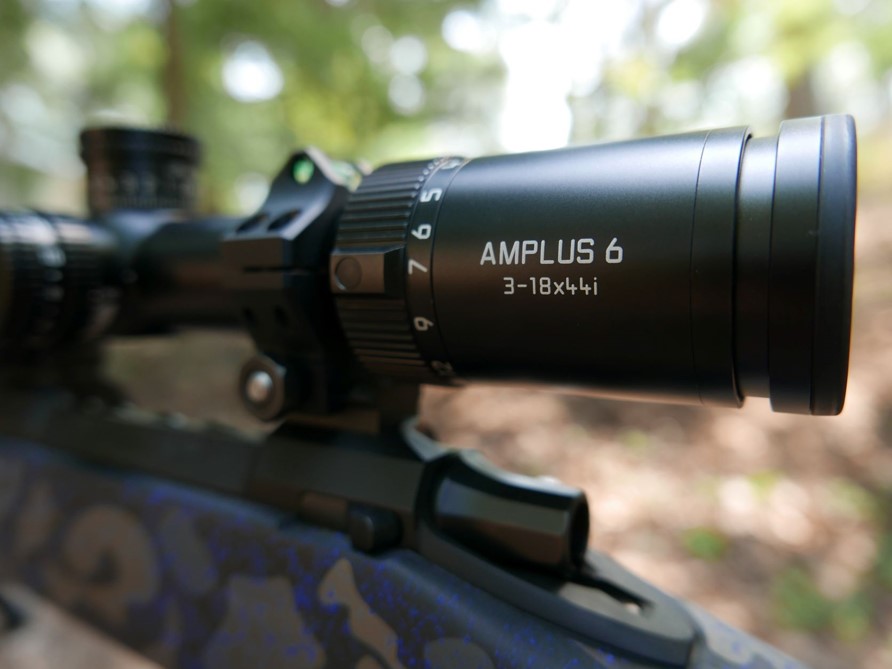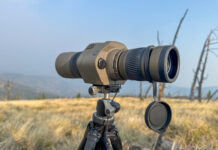
Most of my rifle hunting occurs in steep, heavily timbered terrain where shots are either close and quick (think under 75 yards) or stretched out across a canyon. My preferred rifle scope design is something lightweight with lower power on the bottom end for close shots, and high power in the 15x-18x range for the longer, more calculated shot opportunities. The extended range shots require a scope capable of quick and consistent compensation of bullet drop and reliable return to zero. It also has to be durable, weatherproof, and hold zero in the wet, mountainous landscape I hunt.
Leica Amplus 6
This past year an opportunity surfaced to field test a Leica Amplus 6 rifle scope. With several different models to choose from, I selected the 3-18x44i iteration as one that would fit the conditions of use described above. The weight of this model comes in at 23 ounces making it trim enough to throw on most all-purpose rifles. Its low-end power (3x) is preferred for close range, dark timber situations, and the high-end power (18x) is ideal for longer shots.
The main tube is 30mm and the objective lens is 44mm. This model of the Amplus 6 offers a total of 130 minutes of adjustment with 20 minutes per turn of the turret. With a rifle action (Defiance Deviant) with a built-in 20 moa base and secured with Hawkins Precision low rings (0.885”) there are 78 minutes of vertical adjustments in the scope.

Eye Relief
Mounted in the low rings, the bolt of the rifle cleared easily when lifted and the objective lens housing has a gap over .25 inches above the barrel shank. The ring mounting surface has ample space and finding an optimal position wasn’t an issue with the 5.9 inches of mounting space available. The eye relief at high power is forgiving with no need to hunt for the sweet spot.

Amplus 6 Reticle
On the left side of the scope, there is a parallax adjustment ring with a range of 20 yards to infinity. On the same left-side turret there are 10 light level settings for the illuminated reticle dot that alternate on and off. The windage adjustment is a capped turret and has the same ¼ MOA adjustments as the elevation turret. The exposed elevation turret has an adjustable zero-stop MOA turret. The reticle in the Amplus 6 is second focal plane and is called the L-Ballistic MoA. It is a “Christmas tree” style reticle with 1 moa windage and elevation subtension marks.

These subtension marks were validated at the range using a measured MOA grid and are within dimensions. The reticle is a second focal plane type and is only valid at 18x. This is something to keep in mind when using the reticle marks for wind holds and vertical adjustments. Personally, this isn’t a problem as I usually use maximum magnification when shooting long distances whereas I prefer to use the subtension marks for wind. I am consistent with this in all forms of practice so things don’t fall apart in the pressure situations of hunting.
Return To Zero
The load used in the rifle setup is a heavy bullet pushed at high velocity which has subjected the scope to heavy recoil without any ring slippage or internal damage. Box testing at the range has confirmed the windage adjustments track consistently as do the elevation adjustments. Testing the turret reliability, I’ve repeatedly twisted the turret at random times at home and validated the return to zero at the next range visit. The results have been a consistent return without any shift in zero.
Zero Retention
A few readers on the forum have asked if a Formidilosus-style drop test would be performed on this scope. Due to a scarcity of components, time, and good weather windows, I did not. What I did test was real-world use in extremely rough conditions as well as general bumps and grinds from daily use—meaning the scope was subject to all the abuses of a typical season of use.
There were plenty of uncased rough truck rides, gear piled high on the rifle in the back seat, and bumps and thumps while strapped to a pack and drug through the brush-choked mountains.
The roughest test occurred while hand carrying the rifle, I tumbled down a steep, brushy hillside in the dark. The rifle and scope smashed onto some rocks and logs and then bounced into my forehead. Both of which sustained exterior damage. My forehead required a trip to the emergency room and the scope had large dings in the turret caps.

Holding zero from the typical uses has not been an issue as I fired a few groups throughout the season and nothing changed. And after the bloody midnight accident, I checked zero at the range and found the rifle to be .4-minutes (0.84 inches) low at the 200-yard zero; acceptable to me and the ranges I shoot. I’ve further tested the tracking and return to zero functions of the Amplus 6 and it has not misdialed or shifted zero with use. After the beating the rife and scope took in the tumble, I am confident in its ability to maintain zero on a hunt.

Turrets
The elevation turret scale is in MOA’s and is slightly less than an inch tall and has large easily read markings. The clicks are positive and solid without slop in the movement.
Zeroing the turret is done simply by removing a thin top cap, lifting the turret and rotating it to zero, and replacing the cap. The zero stop is a hard positive wall without play but does not lock. Not once throughout the test did I have the turret twist accidentally. Overall, I am really pleased with its function and the positive click of adjustment.
Parallax Adjustment
The parallax adjustment is effective and the yardages on the dial mesh with actual ranges. The parallax adjustment is smooth, has easy-to-read numbers, and is simple to operate from behind the rifle. However, I usually ignore the distance marks and use my eye to determine if parallax is corrected.
The reticle isn’t my favorite configuration as it’s a little too busy for my taste. Although it didn’t hinder my ability to make a quick off-hand shot on a black bear in very low light. The illuminated dot wasn’t used while hunting but found the range of brightness settings to be wide. The lowest setting is only visible in the darkest of conditions. The brightest setting can be seen on overcast days.

Amplus 6 Glass Clarity
The clarity of the glass is exceptional as is the color it renders. To my eye, it is clearer than the Maven RS.3 that I’ve been using. At low light, on 18x, the target is easily visible; meaning it gathers enough light to shoot up to the end of legal shooting hours. Once focused the image in the scope is clear from edge to edge. The magnification adjustment ring is butter smooth and turns with minimal effort. It has a very positive grip for use with thick gloves. And, it is printed with large white letters for quick verification of the power setting.
Conclusion
Overall, the Leica Amplus 6 is an outstanding rifle scope. It has an ideal magnification range for close-up shots in thick timber or long-range shots when the opportunities arise. At 23 ounces, it doesn’t feel like a brick mounted to the top of the rifle. It is incredibly clear, tracks accurately, and returns to zero without error. Most importantly the build is durable and holds zero under abuse. The scope was subjected to torrential rain, mud, freezing temperatures, and alder-choked avalanche chutes. Even cartwheels down a mountainside and it’s still functioning without issue.
The Amplus 6 is perfect for anyone looking for a light, trim scope in the 3-18 power range. The Amplus sells here for $1399 and comes with Leica’s 10-year Passport Protection Plan plus a 30-year Manufacturer’s Warranty.
Comment on this review or ask Josh questions here.
Check out the rest of our optics reviews here.



















